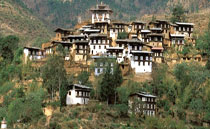Bhutan District - Wangdue Phodrang


Introduction
It's 21km from Punakha to Wangdue Phodrang. roads. The main road climbs the length of the spur and on the left, across the river, comes the first glimpse of the picturesque village of Rinchengang whose inhabitants are celebrated stonemasons. It is the last town of western Bhutan before you enter into the central part of Bhutan. Known for fine bamboo work and its slate carvings.
History
Wangdi is important in the history of Bhutan because in the early days it was the country’s secondary capital. After Trongsa Dzong was established in 1644, the penlop of Wangdue Phodrang became the third most powerful ruler, after the penlops of Paro and Trongsa.
Wangdue Phodrang Dzong was founded by the Shabdrung in 1638. Legends relate that the Shabdrung Ngawang Namgyal met a small boy named Wangdi playing in the sand on the banks of the Punak Chuu and was moved to name the new dzong Wangdi – later Wangdue – Phodrang (Wangdi's Palace).
Attractions
Rinchengang Village:- it isa small clustered village facing the Wangdue Dzong is known for its skill in traditional method of stone masonry. It is about 20 minutes hike uphill with great view of the Dzong, valley and the river.
Phobjikha Valley:- It is at altitude 9600 feet, takes about two hours of drive from Wangdue Phodrang, a glacial valley located on the western slopes of the Black Mountain at an altitude of 9840 feet above the sea level. There is no telephone or electricity and is the winter home to the rare black-necked crane that migrate from high plateaus of Tibet in late fall to escape harsh winters. There are also muntjak (barking deer), wild boar, sambar, Himalayan black bear, leopard and red fox. The valley is a designated conservation area and borders Black Mountain National Park.
Gangtey Goenpa:- It is the largest Nyingma monastery in Bhutan. Gyalse Pema Thinlay built a small temple in 1613, which was later built into larger Goenpa by the 2nd reincarnation Tenzin Legpai Dhendup.